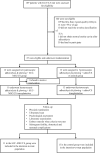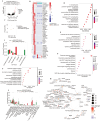hUC-MSCs loaded collagen scaffold for refractory thin endometrium caused by Asherman syndrome: a double-blind randomized controlled trial
- PMID: 40371958
- PMCID: PMC12079654
- DOI: 10.1093/stcltm/szaf011
hUC-MSCs loaded collagen scaffold for refractory thin endometrium caused by Asherman syndrome: a double-blind randomized controlled trial
Abstract
In this single-center, double-blinded, randomized controlled trial, we investigated whether human umbilical cord-derived mesenchymal stromal cells loaded collagen scaffolds (hUC-MSC/CS) could improve the cumulative live-birth rate (cLBR) in infertile women with refractory thin endometrium (RTE). We randomly assigned 25 subfertile women with RTE, in a 1:1 ratio, to receive hysteroscopic adhesiolysis and plowing plus either hUC-MSC/CS or saline/CS (control) for intrauterine implantation. Uterine fluid was collected on the embryo transfer day for RNA-sequencing to explore the potential mechanisms by which hUC-MSCs exert their effects. The primary outcome was the cLBR. Live births occurred in 3 out of 11 women in the hUC-MSC/CS group and in 1 out of 13 women in the control group (27.3% vs 7.7%; relative risk [RR], 3.55; 95% confidence interval [CI], 0.43 to 29.42; P = .30). The cumulative frequencies of clinical pregnancy were 5/11 and 1/13 in the hUC-MSC/CS group and control group, respectively (45.5% vs. 7.7%; RR, 5.91; 95% CI, 0.81-43.28; P = .06). Two of 11 participants developed urticaria in the hUC-MSC/CS group. Enrichment analysis showed that T-cell activation had the largest proportion in the biological process category. Kyoto Encyclopedia of Genes and Genomes pathway analysis showed that most genes were related to cytokine-cytokine receptor interaction. In conclusion, there was a non-significant trend toward a higher cLBR with hUC-MSC/CS compared to controls, potentially through the cytokine-cytokine receptor interaction pathway. hUC-MSCs appeared to be relatively safe in a 1-year follow-up. Therefore, this novel therapy can be proposed to patients with RTE.
Keywords: Asherman syndrome; clinical trial; intrauterine adhesion; mesenchymal stem cell; thin endometrium.
© The Author(s) 2025. Published by Oxford University Press.
Conflict of interest statement
None declared.
Figures



Similar articles
-
Unresponsive thin endometrium caused by Asherman syndrome treated with umbilical cord mesenchymal stem cells on collagen scaffolds: a pilot study.Stem Cell Res Ther. 2021 Jul 22;12(1):420. doi: 10.1186/s13287-021-02499-z. Stem Cell Res Ther. 2021. PMID: 34294152 Free PMC article.
-
A collagen scaffold loaded with human umbilical cord-derived mesenchymal stem cells facilitates endometrial regeneration and restores fertility.Acta Biomater. 2019 Jul 1;92:160-171. doi: 10.1016/j.actbio.2019.05.012. Epub 2019 May 7. Acta Biomater. 2019. PMID: 31075515
-
Therapeutic evidence of umbilical cord-derived mesenchymal stem cell transplantation for cerebral palsy: a randomized, controlled trial.Stem Cell Res Ther. 2020 Feb 3;11(1):43. doi: 10.1186/s13287-019-1545-x. Stem Cell Res Ther. 2020. PMID: 32014055 Free PMC article. Clinical Trial.
-
Adult stem cells in endometrial regeneration: Molecular insights and clinical applications.Mol Reprod Dev. 2021 Jun;88(6):379-394. doi: 10.1002/mrd.23476. Epub 2021 May 20. Mol Reprod Dev. 2021. PMID: 34014590 Free PMC article. Review.
-
An update on stem cell therapy for Asherman syndrome.J Assist Reprod Genet. 2020 Jul;37(7):1511-1529. doi: 10.1007/s10815-020-01801-x. Epub 2020 May 22. J Assist Reprod Genet. 2020. PMID: 32445154 Free PMC article. Review.
References
-
- Liu KE, Hartman M, Hartman A, Luo ZC, Mahutte N.. The impact of a thin endometrial lining on fresh and frozen–thaw IVF outcomes: an analysis of over 40 000 embryo transfers. Hum Reprod. 2018;33:1883-1888. https://doi.org/10.1093/humrep/dey281 - DOI - PMC - PubMed
-
- Lv H, Zhao G, Jiang P, et al.Deciphering the endometrial niche of human thin endometrium at single-cell resolution. Proc Natl Acad Sci U S A. 2022;119:e2115912119. https://doi.org/10.1073/pnas.2115912119 - DOI - PMC - PubMed
-
- Lai S, Zhang L, Luo Y, et al.A sonographic endometrial thickness <7 mm in women undergoing in vitro fertilization increases the risk of placenta accreta spectrum. Am J Obstet Gynecol. 2024;231:557.e1-557.e18. https://doi.org/10.1016/j.ajog.2024.02.301 - DOI - PubMed
-
- Kasius A, Smit JG, Torrance HL, et al.Endometrial thickness and pregnancy rates after IVF: a systematic review and meta-analysis. Hum Reprod Update. 2014;20:530-541. https://doi.org/10.1093/humupd/dmu011 - DOI - PubMed
-
- Zhang Y, Shi L, Lin X, et al.Unresponsive thin endometrium caused by Asherman syndrome treated with umbilical cord mesenchymal stem cells on collagen scaffolds: a pilot study. Stem Cell Res Ther. 2021;12:420. https://doi.org/10.1186/s13287-021-02499-z - DOI - PMC - PubMed
Publication types
MeSH terms
Substances
Grants and funding
- 2018YFC1004800/National Key Research and Development Program of China
- 2021YFC2700404/National Key Research and Development Program of China
- 82371682/National Natural Science Foundation of China
- 81801537/National Natural Science Foundation of China
- 82271628/National Natural Science Foundation of China
LinkOut - more resources
Full Text Sources

